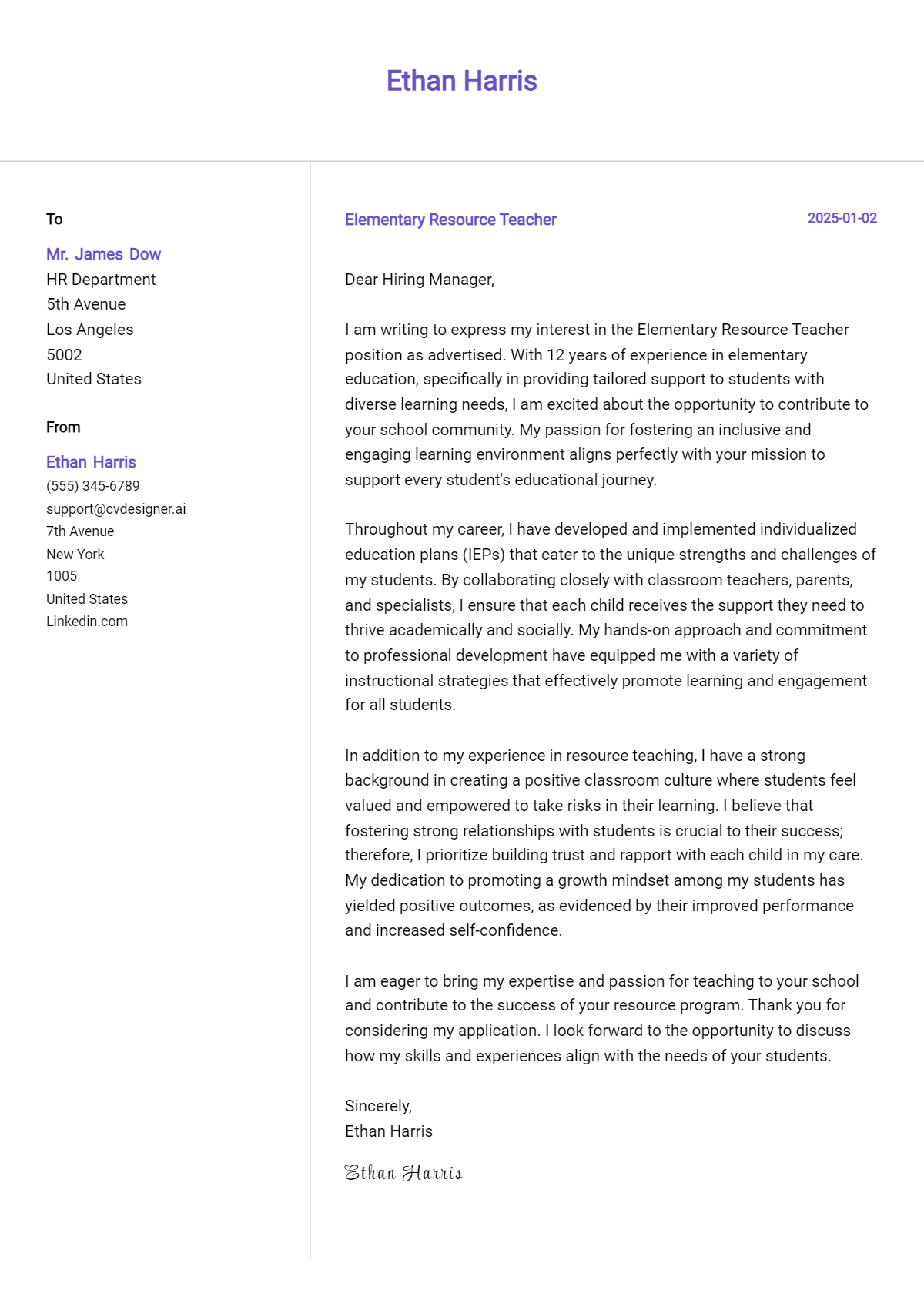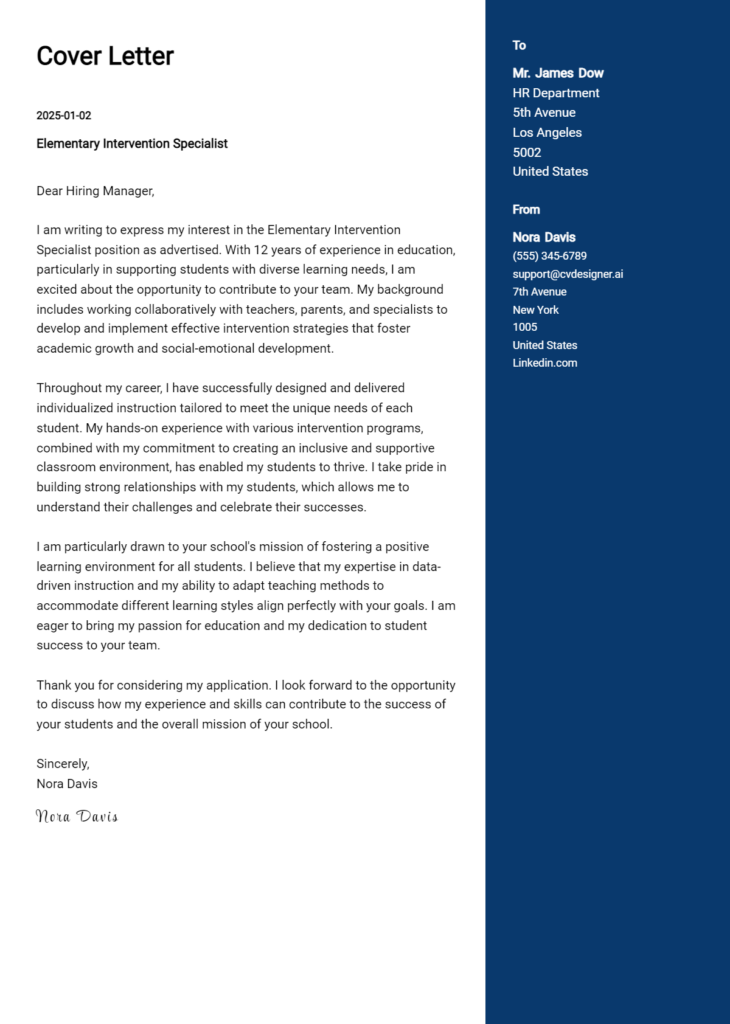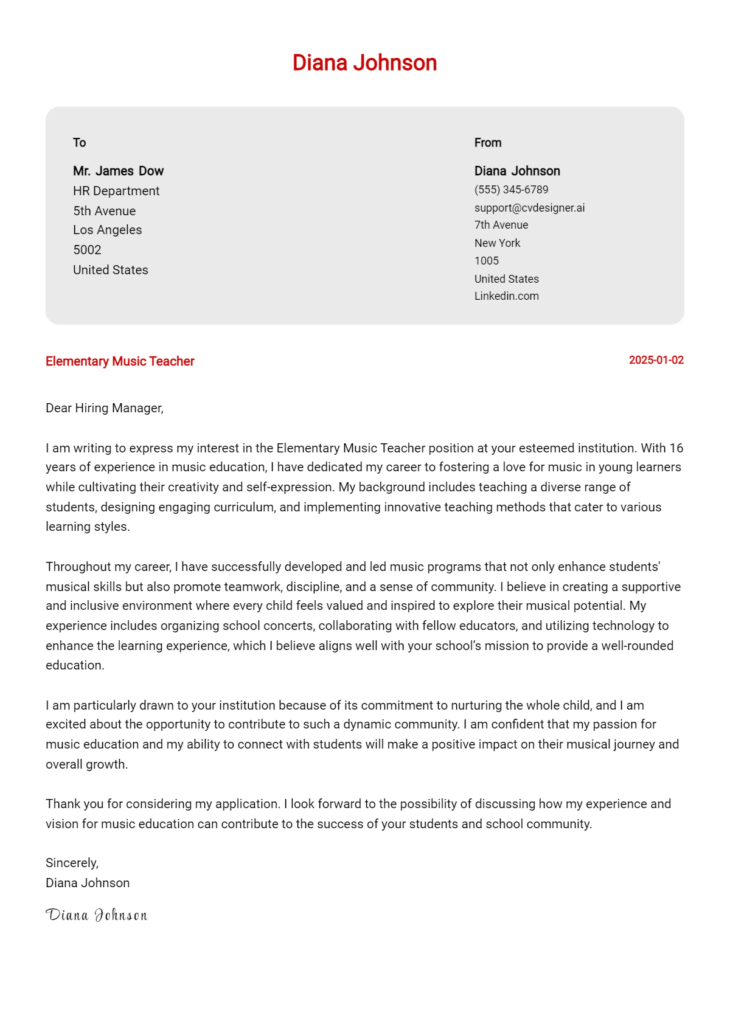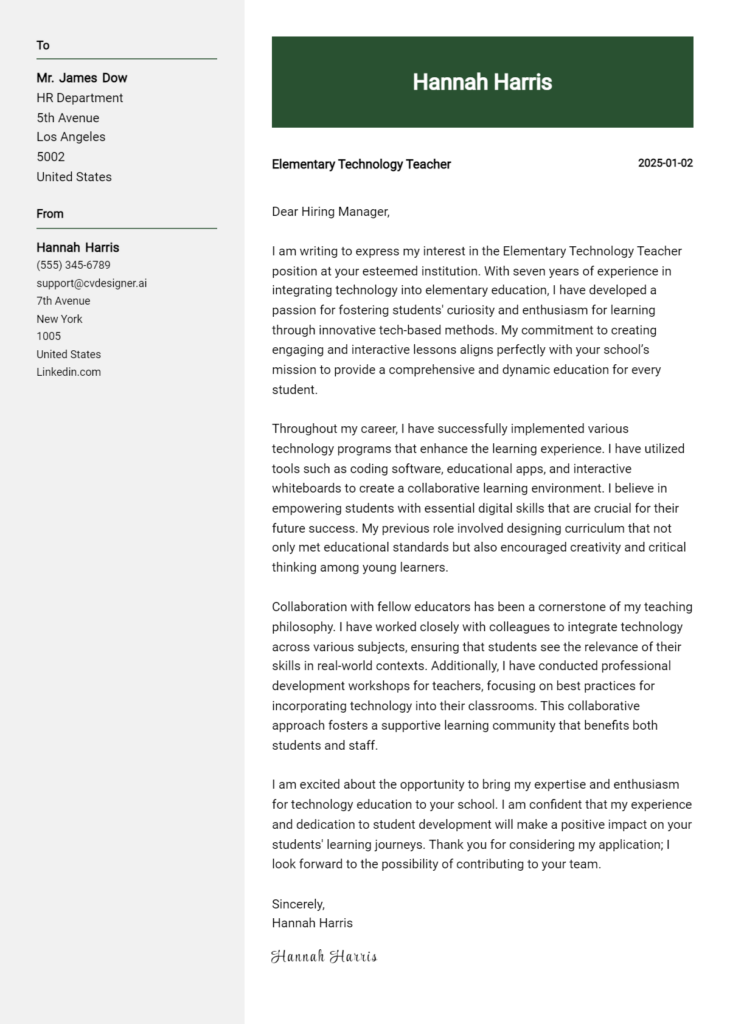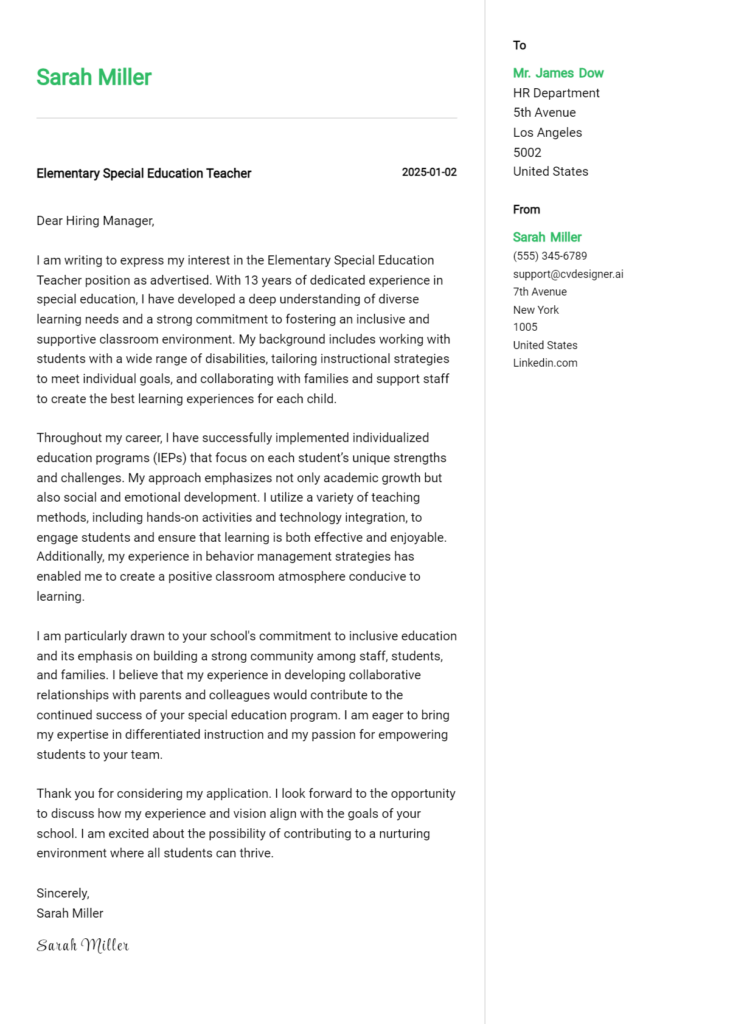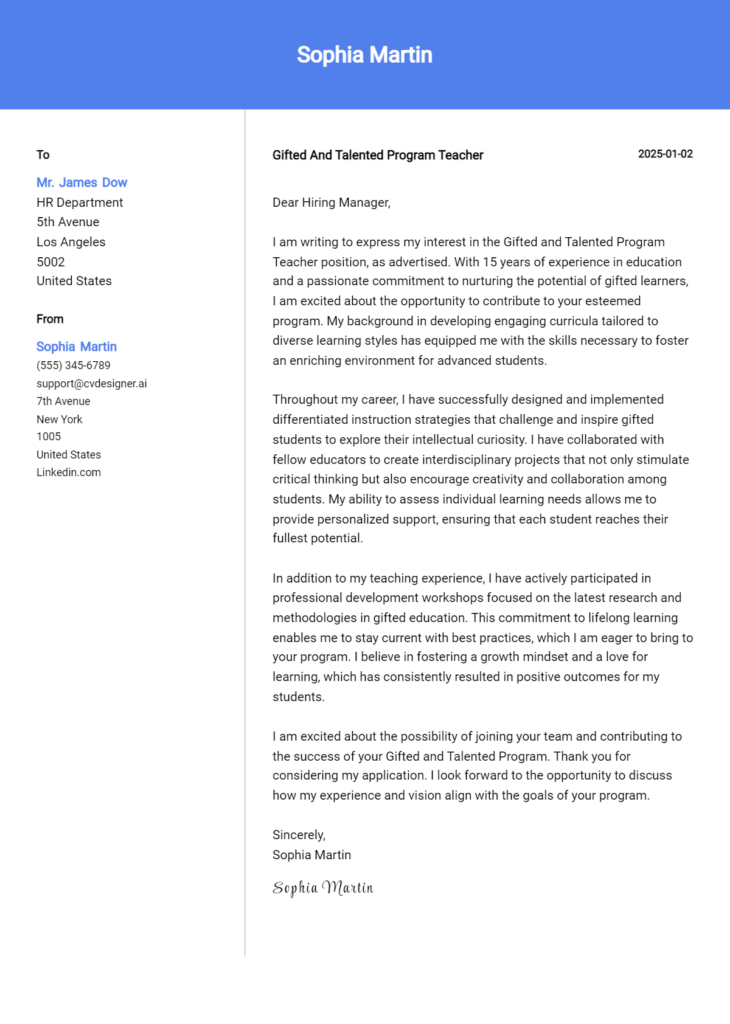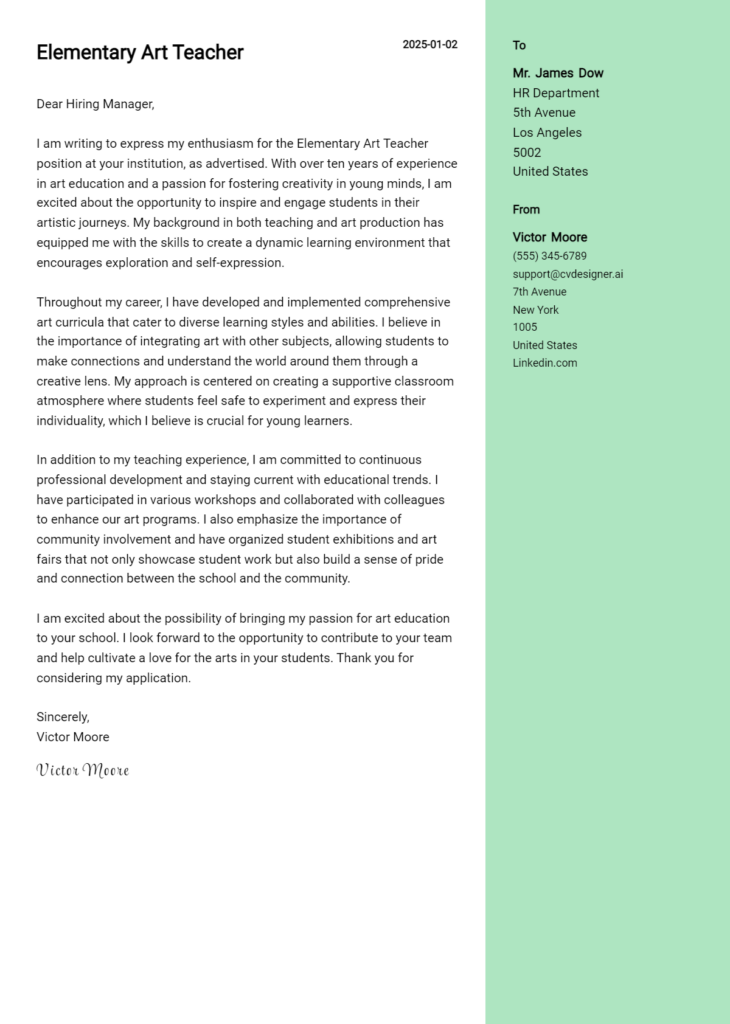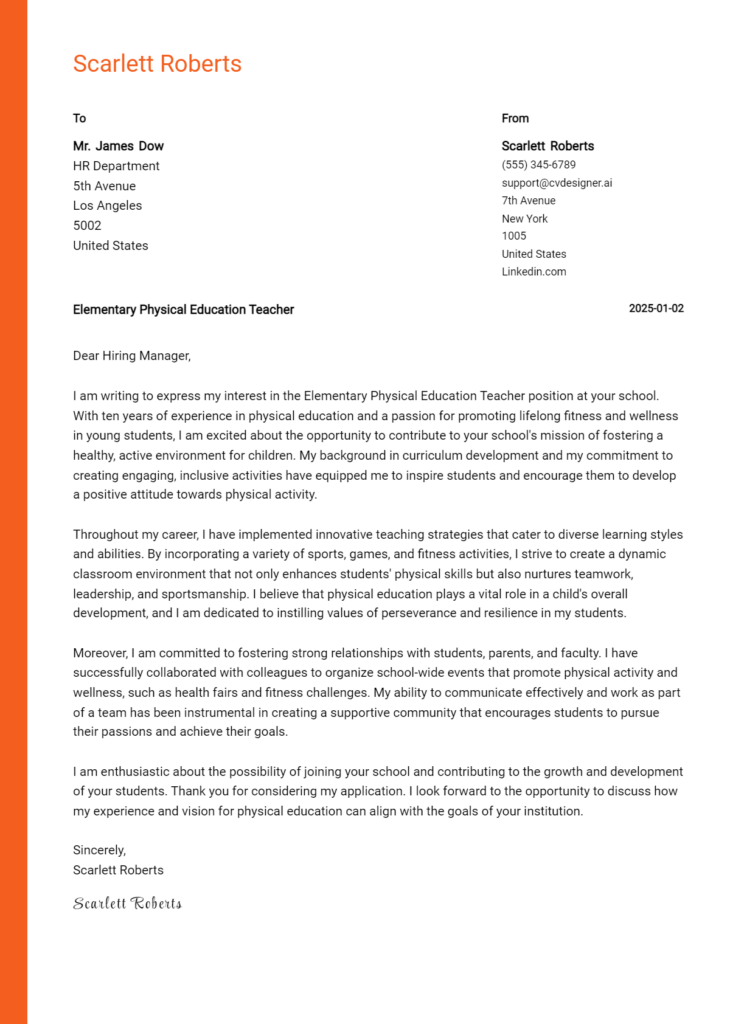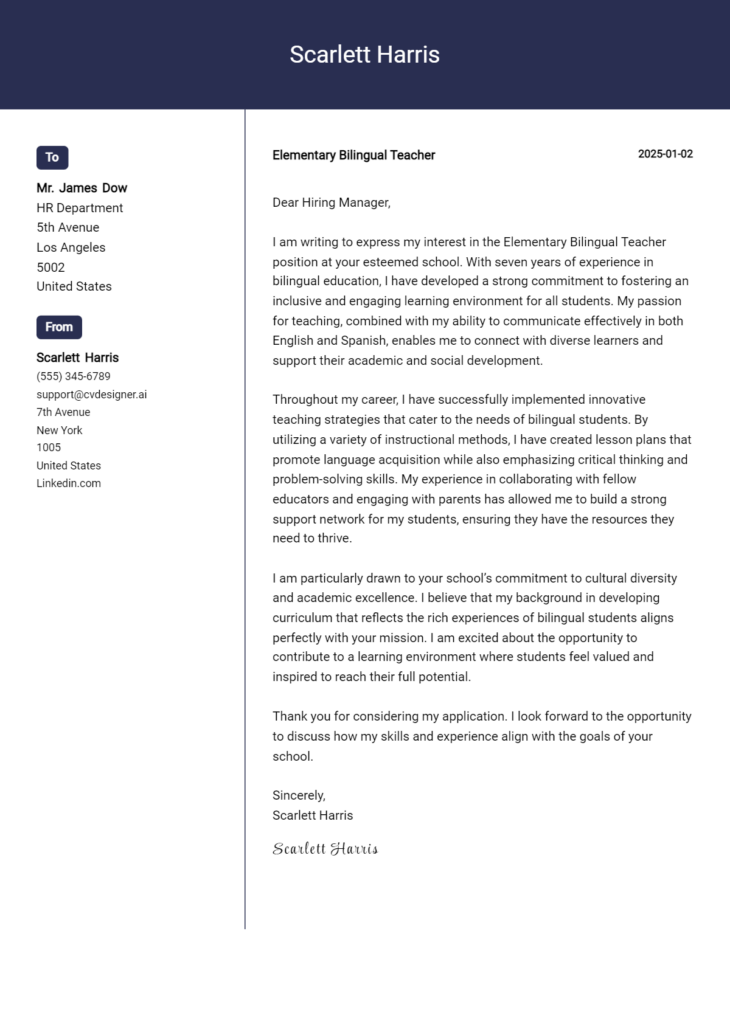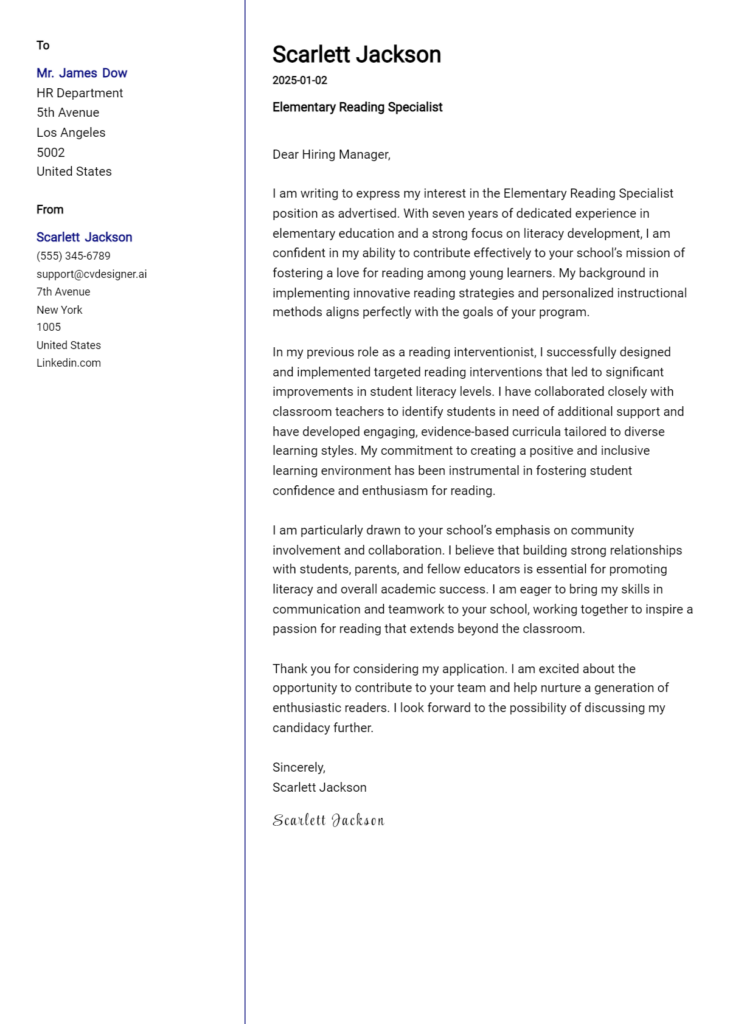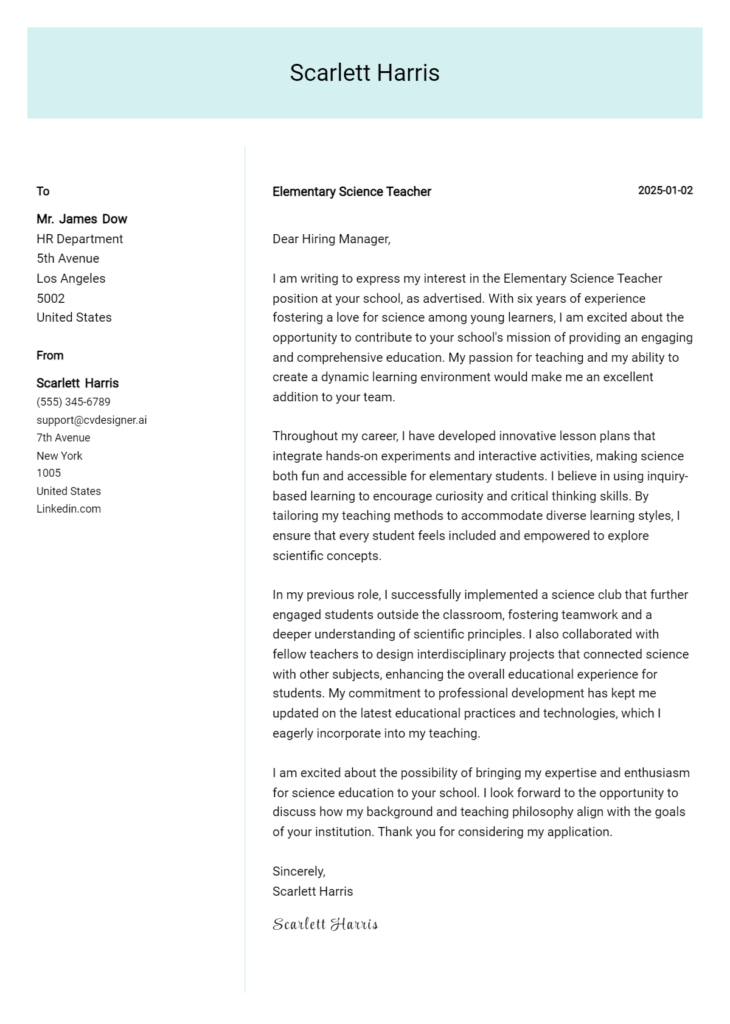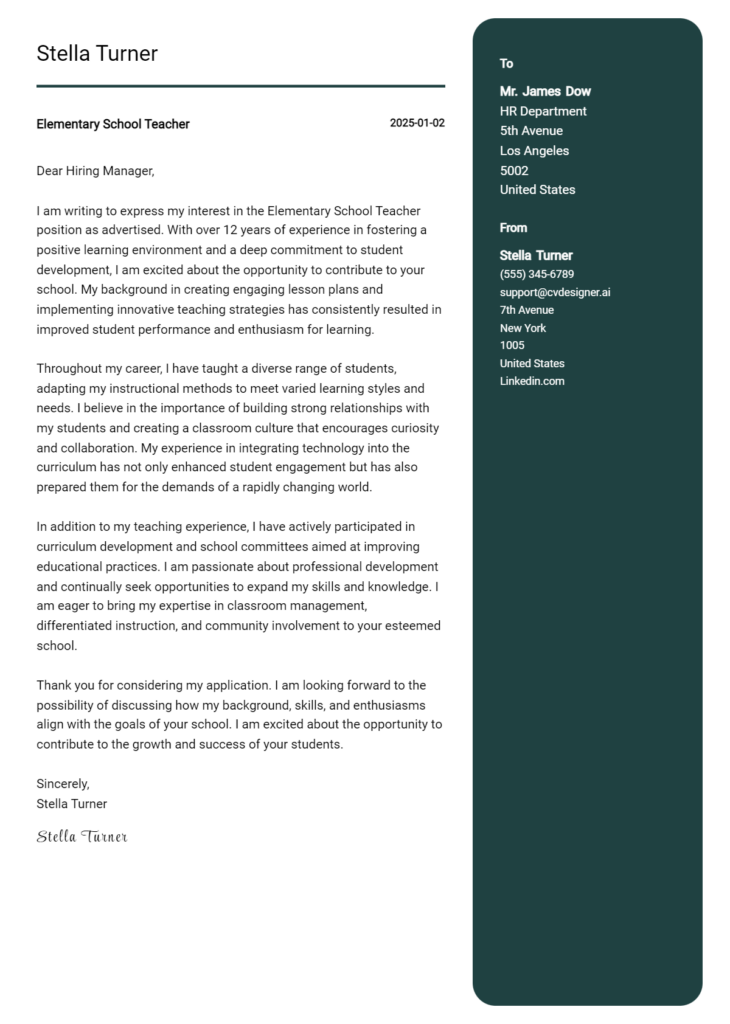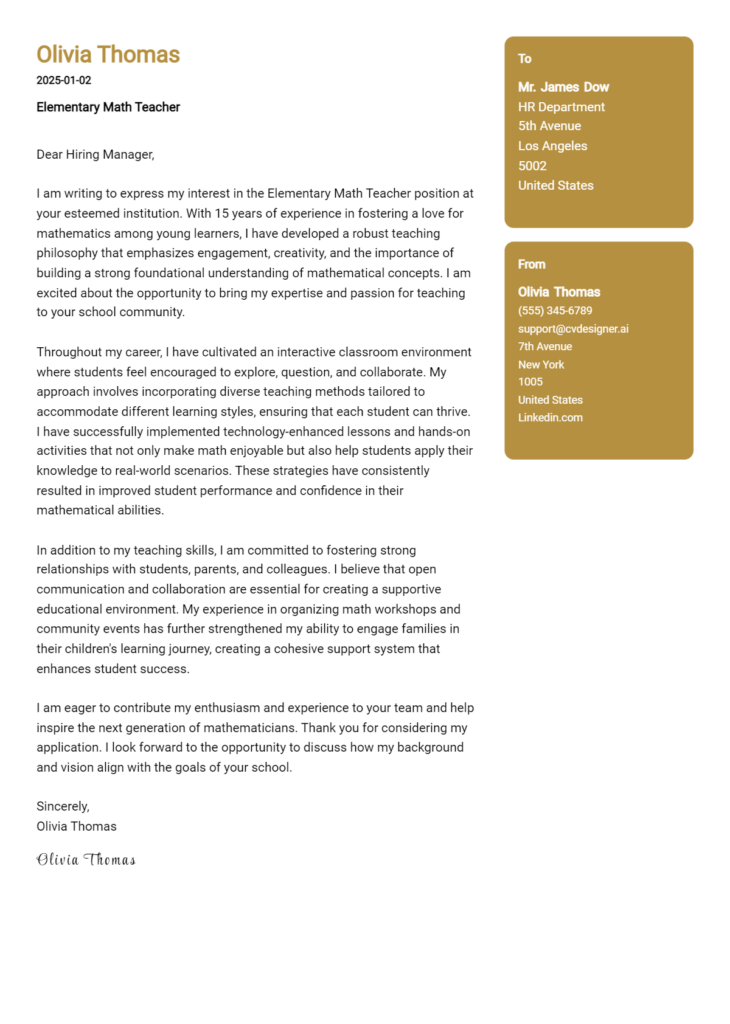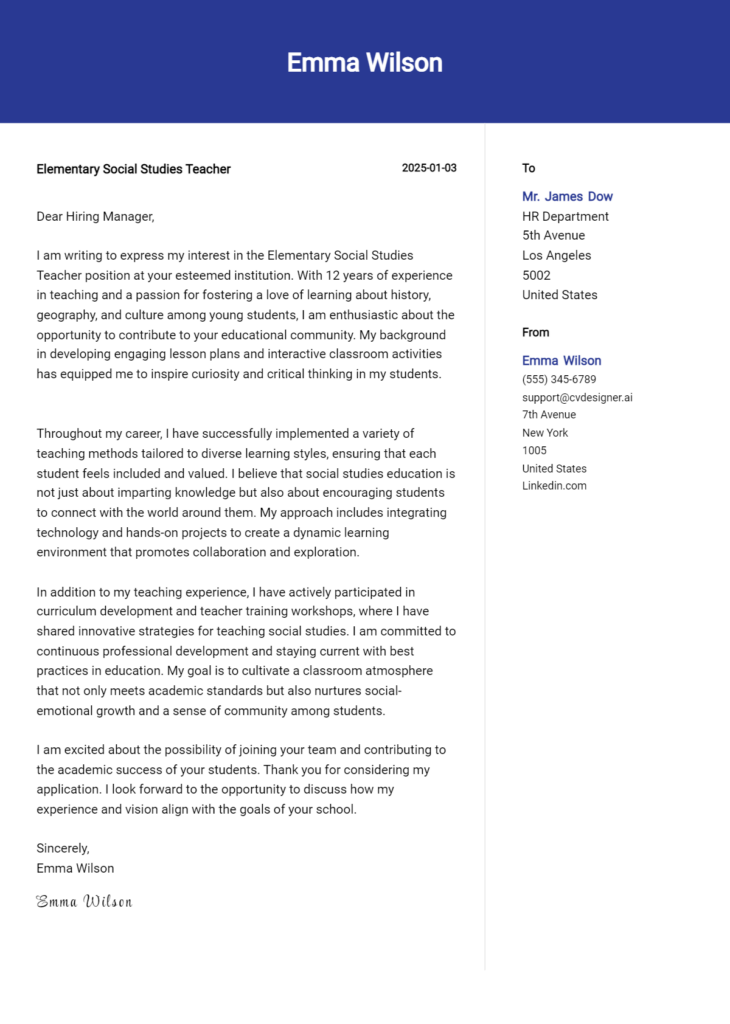Elementary Resource Teacher Cover Letter Examples
Explore additional Elementary Resource Teacher cover letter samples and guides and see what works for your level of experience or role.
How to Format an Elementary Resource Teacher Cover Letter
Crafting a compelling cover letter is essential for an Elementary Resource Teacher, as it serves as your first opportunity to make a lasting impression on potential employers. The format of your cover letter is not just a matter of aesthetics; it reflects your organizational skills and your ability to communicate effectively—qualities that are particularly important in the educational field. A well-structured cover letter can highlight your teaching philosophy, experience with diverse learners, and commitment to fostering an inclusive learning environment.
In this guide, we will outline how to structure your cover letter to make it both professional and engaging. We’ll break down the essential components, including:
- Cover Letter Header
- Cover Letter Greeting
- Cover Letter Introduction
- Cover Letter Body
- Cover Letter Closing
Each section is crucial in presenting your qualifications and showcasing your dedication to supporting students with varying needs. Let’s delve into each part to help you create an outstanding cover letter that resonates with hiring committees.
Importance of the Cover Letter Header for an Elementary Resource Teacher
The cover letter header is a crucial component of your application, as it sets the tone for the entire document and provides essential information about you to the hiring committee. A well-structured header enhances clarity and professionalism, ensuring that your application stands out. It should include your contact information, the date, and the recipient's details, allowing the reader to easily identify and reach you. A clear and organized header conveys your attention to detail and respect for the application process, which is especially important for an Elementary Resource Teacher, who plays a vital role in the educational development of students.
Strong Example
Jane Doe 123 Learning Lane Education City, ST 12345 jane.doe@email.com (123) 456-7890 October 15, 2023 Mr. John Smith Hiring Manager Sunnydale Elementary School 456 School Road Education City, ST 12345
Weak Example
jane doe October 15, 2023 To Whom It May Concern
The Importance of the Cover Letter Greeting
The greeting of a cover letter is a crucial element that sets the tone for the entire document. A well-crafted greeting can convey professionalism and establish a connection with the hiring manager, making it clear that the applicant has taken the time to personalize their application. Addressing the hiring manager directly demonstrates respect and attention to detail, which are essential traits for an Elementary Resource Teacher who will be interacting with students, parents, and staff alike. To avoid sounding generic, it is important to research the recipient's name when possible, as this small effort can make a significant difference in the impression you create.
Tips for an Effective Greeting:
- Always try to use the hiring manager's name (e.g., "Dear Ms. Smith" or "Dear Mr. Johnson").
- If the name is not available, consider addressing the department (e.g., "Dear Hiring Committee").
- Avoid generic greetings like "To Whom It May Concern," which can come across as impersonal.
Strong Greeting Example:
Strong Example
Dear Mrs. Thompson,
Weak Greeting Example:
Weak Example
To Whom It May Concern,
By following these guidelines, candidates can craft a compelling cover letter greeting that enhances their overall application and demonstrates their suitability for the role of an Elementary Resource Teacher.
Cover Letter Introduction for Elementary Resource Teacher
A well-crafted cover letter introduction is crucial for an Elementary Resource Teacher as it serves as the first impression to the hiring manager. This initial paragraph should not only capture their attention but also convey the candidate’s genuine interest in the position. It is an opportunity to briefly showcase key skills or achievements that align with the needs of the school and its students. A strong introduction sets the tone for the rest of the letter, demonstrating enthusiasm and professionalism, while a weak one may fail to engage the reader or communicate the candidate's qualifications effectively.
Strong Example
Dear Hiring Manager, As a dedicated and passionate Elementary Resource Teacher with over five years of experience in special education, I was thrilled to discover the opening at [School Name]. I believe that every child deserves the opportunity to succeed, and I have a proven track record of creating inclusive learning environments that cater to diverse learning needs. My commitment to fostering academic growth and social-emotional development in students has led to significant improvements in student performance, which I am eager to bring to your team.
Weak Example
To whom it may concern, I am writing to apply for the Elementary Resource Teacher position. I have a degree in education and have worked with kids before. I think I would be a good fit for the job, and I hope you consider my application.
Cover Letter Body for Elementary Resource Teacher
The body of a cover letter for an Elementary Resource Teacher serves as a crucial opportunity for candidates to articulate their qualifications, experiences, and how they can contribute to the educational environment. It is the section where applicants can showcase their unique skills and highlight specific projects or accomplishments that demonstrate their effectiveness in supporting diverse learners. A well-crafted cover letter body can illustrate the candidate's commitment to fostering an inclusive classroom, their ability to collaborate with other educators, and their innovative approach to addressing individual student needs. By providing concrete examples of past successes, candidates can effectively capture the attention of hiring committees and convey the value they bring to the school.
Strong Example
I am excited to apply for the Elementary Resource Teacher position at XYZ School, where I can leverage my experience in developing individualized education plans (IEPs) for students with varying needs. During my previous role at ABC Elementary, I implemented a successful reading intervention program that resulted in a 30% increase in literacy rates among students with learning disabilities. Collaborating closely with classroom teachers, I designed and facilitated workshops focused on differentiated instruction strategies, enabling them to better support all learners. I am particularly proud of my role in mentoring new teachers, where I shared best practices that fostered a collaborative learning environment. I am eager to bring this same dedication and innovative approach to your team at XYZ School, ensuring every child reaches their full potential.
Weak Example
I want to be an Elementary Resource Teacher because I like working with kids. I have taught before and helped some students. I think I can do a good job. I am looking for a new job and I hope you consider me. I haven’t really worked on any special projects, but I am willing to learn. Thank you for reading my letter.
Importance of the Cover Letter Closing for an Elementary Resource Teacher
The closing paragraph of a cover letter is crucial as it provides the final opportunity to summarize qualifications, express enthusiasm for the position, and encourage the hiring manager to take the next steps. For an Elementary Resource Teacher, this section should highlight relevant skills such as adaptability, collaboration, and dedication to student success while reiterating a strong interest in fostering an inclusive learning environment. A well-crafted closing can leave a lasting impression, prompting the reader to review the resume and consider scheduling an interview.
Strong Example
Thank you for considering my application for the Elementary Resource Teacher position. With my extensive experience in differentiated instruction and a strong commitment to supporting students with diverse learning needs, I am excited about the opportunity to contribute to your school community. I believe that every child can succeed with the right support, and I look forward to the possibility of discussing how my background and passion align with your goals. I am eager to bring my skills to your team and would appreciate the chance to discuss my application further. Please feel free to contact me to schedule an interview at your convenience.
Weak Example
In conclusion, I hope you think about my application. I have some experience in teaching, and I might be a good fit for the job. If you want to talk, you can look at my resume. Thanks for your time.
These tips will help candidates craft an effective cover letter for an Elementary Resource Teacher position. A well-written cover letter not only highlights your qualifications but also showcases your commitment to fostering a positive learning environment for all students. It’s essential to emphasize your technical skills, problem-solving abilities, understanding of the Special Education cycle (SDLC), teamwork experiences, and a passion for continuous learning. By doing so, you can present yourself as a strong candidate who is capable of making a meaningful impact in the classroom.
Cover Letter Writing Tips for Elementary Resource Teacher
Showcase Technical Skills: Highlight your proficiency in using educational technology and adaptive tools that enhance learning for students with diverse needs. Mention specific programs or software you are experienced with, and how they have contributed to your teaching effectiveness. This not only demonstrates your technical capabilities but also your ability to adapt to various teaching methods.
Emphasize Problem-Solving Abilities: Use examples from your teaching experiences where you identified challenges and implemented successful strategies to overcome them. Whether it’s modifying lesson plans or creating individualized education plans (IEPs), illustrate how your problem-solving skills have positively impacted student learning outcomes.
Demonstrate SDLC Knowledge: Familiarize yourself with the Special Education cycle and use your cover letter to explain your understanding of each stage, from assessment and planning to implementation and review. This shows that you are not only knowledgeable but also prepared to navigate the complexities of special education.
Highlight Teamwork Experiences: Collaboration is key in an elementary resource setting. Detail your experience working with other educators, specialists, and families to create a supportive learning environment. Share specific instances where teamwork led to improved student outcomes or enhanced curriculum development.
Express a Passion for Continuous Learning: Convey your commitment to professional development and staying updated with the latest teaching strategies and educational research. Mention any workshops, courses, or certifications you have pursued, and how they have shaped your teaching philosophy. This demonstrates your dedication to providing the best education for your students.
By following these tips, candidates can craft a compelling cover letter that effectively communicates their qualifications and enthusiasm for the role. For additional resources, consider checking out cover letter templates or using a cover letter builder to streamline the writing process.
Common Mistakes to Avoid in an Elementary Resource Teacher Cover Letter
Crafting a compelling cover letter is essential for standing out as an Elementary Resource Teacher candidate. Avoiding common mistakes can make the difference between landing an interview and getting overlooked. Here are some pitfalls to steer clear from:
Generic Greetings: Using "To Whom It May Concern" can come off as impersonal. Instead, address the letter to the hiring manager by name when possible.
Lack of Specificity: Failing to mention specific skills or experiences relevant to the role can make your application forgettable. Tailor your letter to highlight your unique qualifications in special education and resource teaching.
Overly Lengthy Content: A lengthy cover letter can lose the reader's attention. Aim for concise paragraphs that focus on your key achievements and qualifications, adhering to a proper cover letter format.
Neglecting Key Achievements: Omitting important accomplishments can weaken your narrative. Use quantifiable results to demonstrate your impact in previous roles.
Typos and Grammatical Errors: Mistakes can create an impression of carelessness. Proofread your letter multiple times and consider asking a peer to review it as well.
Focusing on What the Job Can Do for You: Instead of centering the letter on your needs, emphasize how your skills and experiences will benefit the school and its students.
Failing to Include a Call to Action: Not expressing your desire for an interview can leave the reader uncertain. Conclude with a proactive statement inviting further discussion about your candidacy.
By steering clear of these common mistakes, you can improve your chances of making a strong impression. For inspiration, check out cover letter examples to guide your writing process.
Cover Letter FAQs for Elementary Resource Teacher
What should I include in my cover letter as an Elementary Resource Teacher?
When crafting your cover letter, start with a strong opening that highlights your passion for education and your commitment to supporting diverse learners. Include specific examples of your teaching philosophy and how it aligns with the school’s mission. Mention your qualifications, such as your degree in special education or relevant certifications. Highlight your experience working with students with varying needs and the strategies you’ve implemented to foster their growth. Finally, express your enthusiasm for the position and your desire to contribute positively to the school community.
How can I make my cover letter stand out?
To make your cover letter memorable, personalize it for the specific school or district you’re applying to. Research the school’s values and recent initiatives related to special education, and reference these in your letter. Use concrete examples from your teaching experience that demonstrate your effectiveness in supporting students with diverse learning needs. Including measurable outcomes from your previous roles, such as improvements in student achievement or engagement, will enhance your credibility. Additionally, keep your tone professional yet warm to convey your genuine interest in the position.
Should I address my cover letter to a specific person?
Yes, addressing your cover letter to a specific person, such as the hiring manager or principal, is highly recommended. This small detail shows that you’ve done your research and are genuinely interested in the position. If the job listing does not specify a name, you can often find this information on the school district’s website or by calling the school’s administrative office. If all else fails, using a general greeting like "Dear Hiring Committee" is acceptable, but a personalized approach is always more engaging.
How long should my cover letter be?
Your cover letter should ideally be one page long, typically consisting of three to four paragraphs. This length allows you to provide enough detail about your qualifications and experiences without overwhelming the reader. Focus on clarity and conciseness; each sentence should serve a purpose. Aim for a balance between being informative and engaging, ensuring that you showcase your personality and passion for teaching while remaining professional. Remember, a well-structured and succinct cover letter will leave a positive impression on hiring committees.
Build your Cover Letter in minutes
Use an AI-powered cover letter builder and have your letter done in 5 minutes. Just select your template and our software will guide you through the process.

